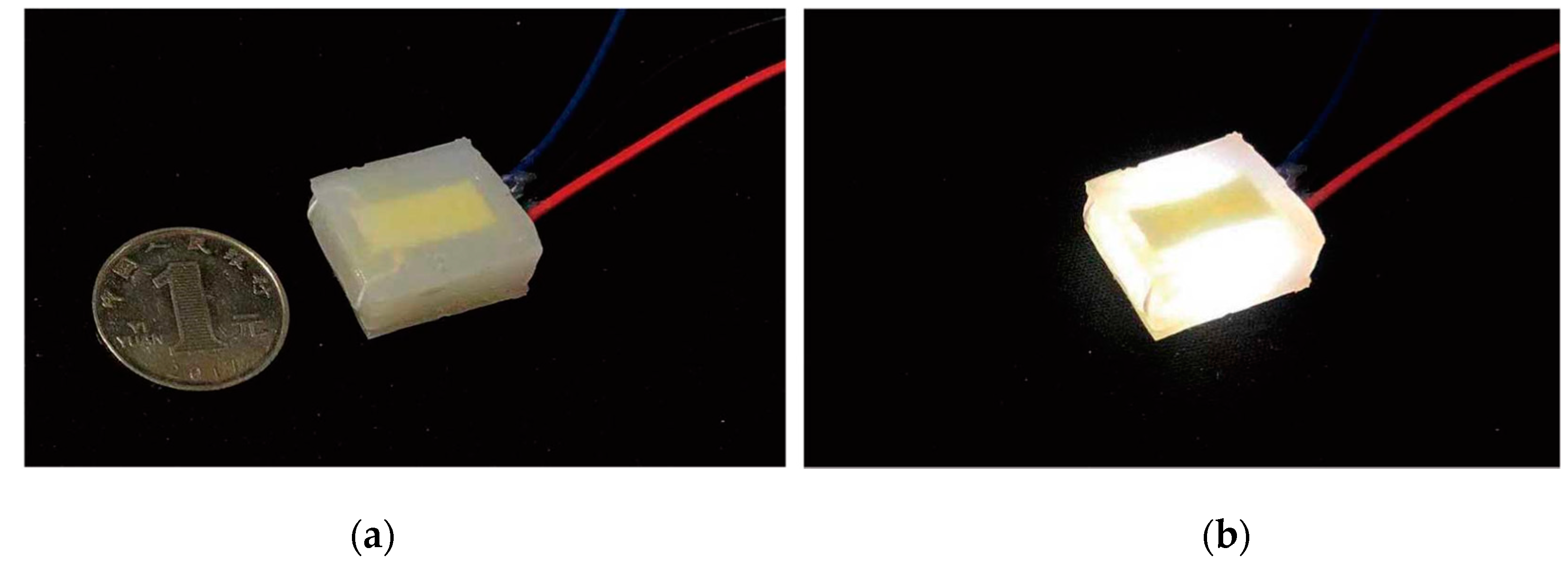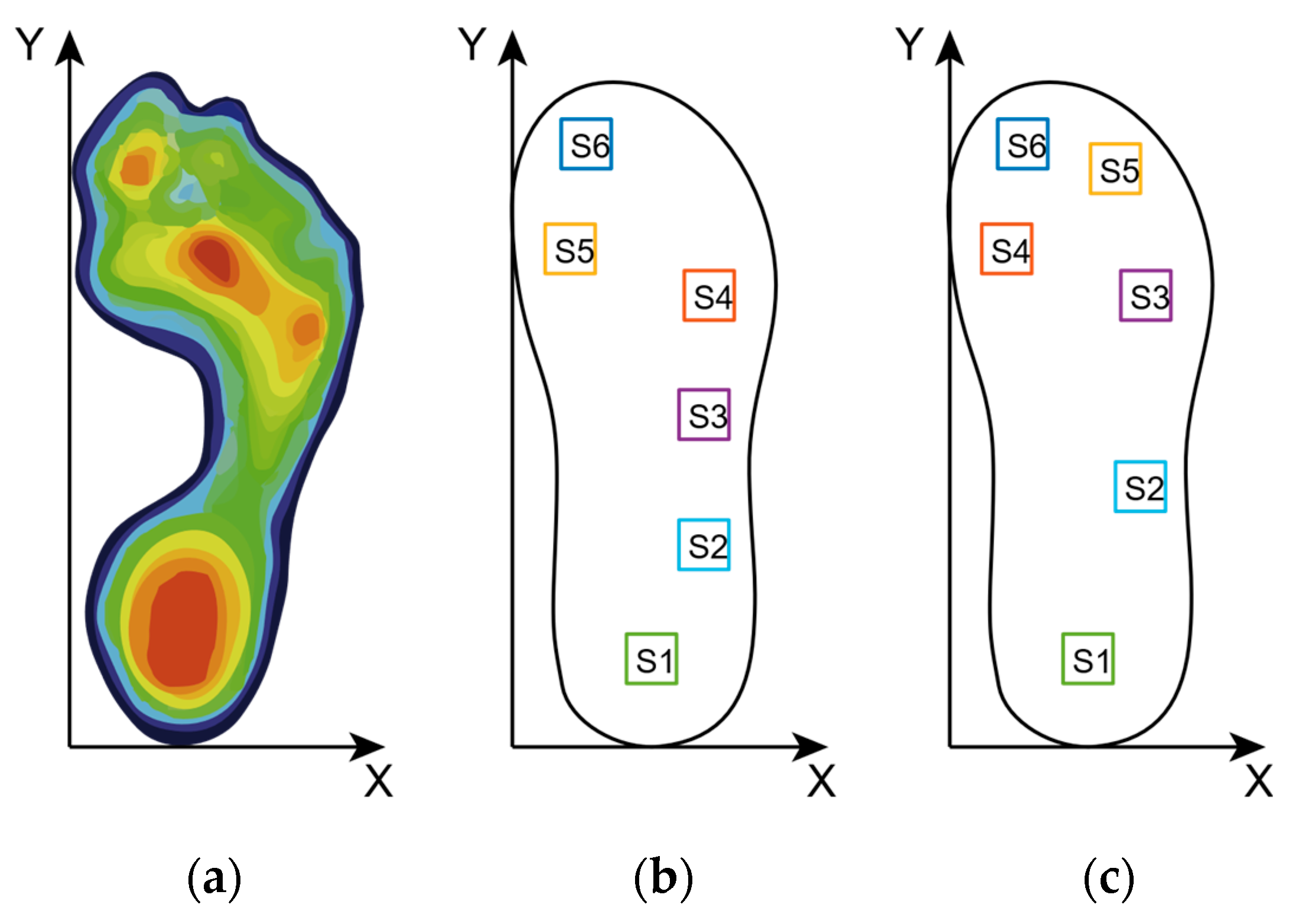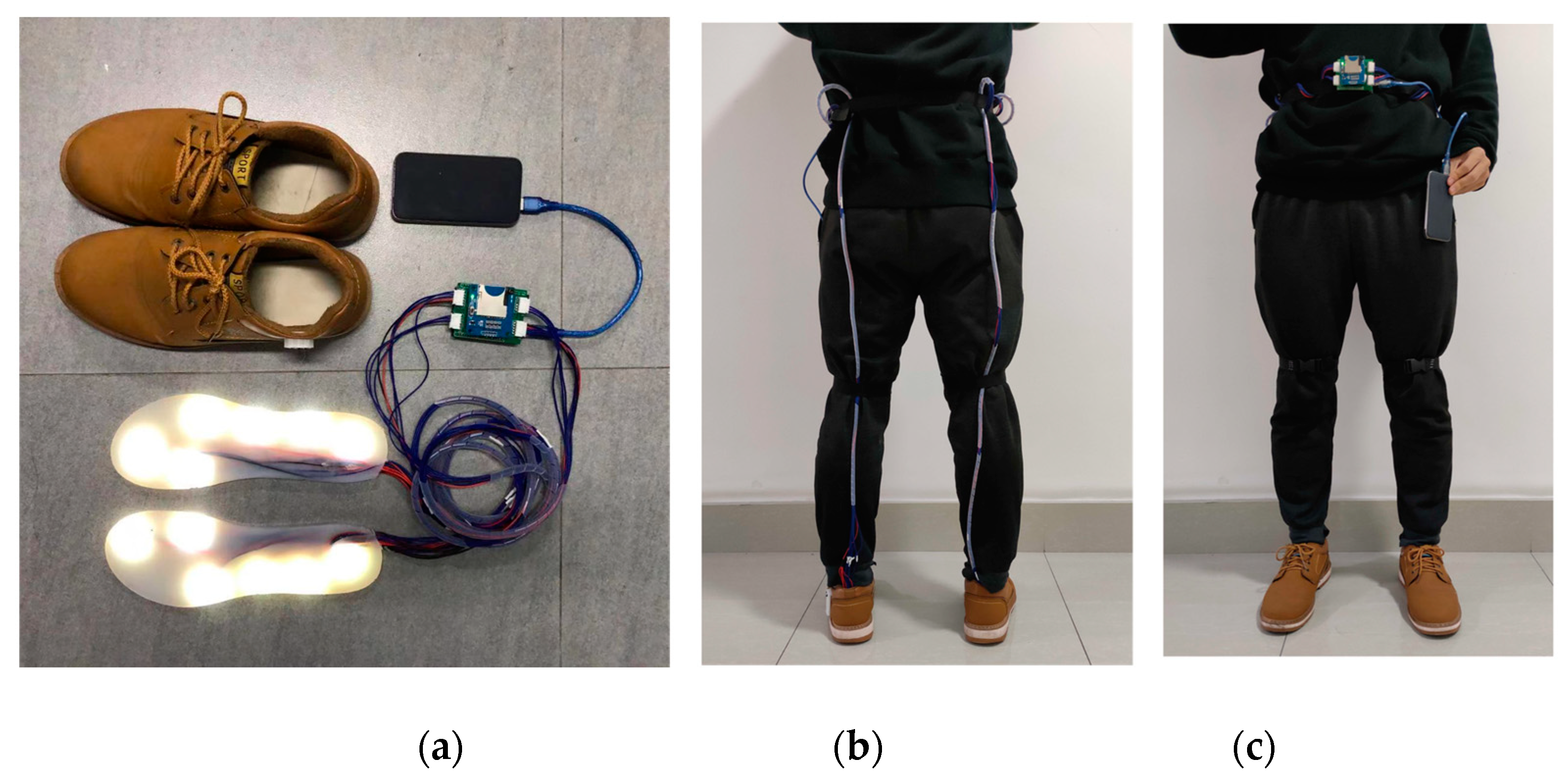Design of a Plantar Pressure Insole Measuring System Based on Modular Photoelectric Pressure Sensor Unit
Abstract
1. Introduction
2. Materials and Methods
2.1. Modular Pressure Sensing Unit
2.1.1. Sensing Principle
2.1.2. Design and Manufacturing
- (a)
- Flexible circuit board
- (b)
- Flexible light-transmitting medium
- (c)
- Integration process
2.1.3. Characteristic Analysis System
2.2. Insole Solution
2.2.1. The Layout of Insole
2.2.2. Insole Manufacturing
2.2.3. Electrical System
2.2.4. Plantar Pressure Center
3. Experiments and Results
3.1. Sensor Characteristic
3.2. Gait Data Collection
3.2.1. Comparison of Insole Solutions
3.2.2. Biped Gait Data Collection
4. Discussion
- (1)
- Swing stage: the sole hardly exerts a force on the insole, and the total pressure is in a stable state and lower than the standing state.
- (2)
- Heel contact stage: the heel touches the ground and bears weight, and the pressure on the heel area increases significantly.
- (3)
- Intermediate stance phase: the heel no longer bears the same pressure as the heel contact phase, and part of the pressure is transferred to the front foot.
- (4)
- Toe off stage: the body’s center of gravity is almost moved to the other side of the body, the heel is off the ground, and the pressure is mainly concentrated on the forefoot.
5. Conclusions
Author Contributions
Funding
Data Availability Statement
Acknowledgments
Conflicts of Interest
References
- Chu, A.; Kazerooni, H.; Zoss, A. On the biomimetic design of the berkeley lower extremity exoskeleton (BLEEX). In Proceedings of the 2005 IEEE International Conference on Robotics and Automation, Barcelona, Spain, 18–22 April 2005; pp. 4345–4352. [Google Scholar]
- Kawamoto, H.; Sankai, Y. Power assist method based on phase sequence and muscle force condition for HAL. Adv. Robot. 2005, 19, 717–734. [Google Scholar] [CrossRef]
- Kazerooni, H.; Steger, R. The Berkeley lower extremity exoskeleton. J. Dyn. Syst. Meas. Control 2006, 128, 14–25. [Google Scholar] [CrossRef]
- Urry, S. Plantar pressure-measurement sensors. Meas. Sci. Technol. 1999, 10, R16. [Google Scholar] [CrossRef]
- Anam, K.; Al-Jumaily, A.A. Active exoskeleton control systems: State of the art. Procedia Eng. 2012, 41, 988–994. [Google Scholar] [CrossRef]
- Kazerooni, H.; Racine, J.-L.; Huang, L.; Steger, R. On the control of the berkeley lower extremity exoskeleton (BLEEX). In Proceedings of the 2005 IEEE International Conference on Robotics and Automation, Barcelona, Spain, 18–22 April 2005; pp. 4353–4360. [Google Scholar]
- Razak, A.H.A.; Zayegh, A.; Begg, R.K.; Wahab, Y. Foot plantar pressure measurement system: A review. Sensors 2012, 12, 9884–9912. [Google Scholar] [CrossRef] [PubMed]
- Cavanagh, P.R.; Lafortune, M.A. Ground reaction forces in distance running. J. Biomech. 1980, 13, 397–406. [Google Scholar] [CrossRef]
- Mengüç, Y.; Park, Y.-L.; Pei, H.; Vogt, D.; Aubin, P.M.; Winchell, E.; Fluke, L.; Stirling, L.; Wood, R.J.; Walsh, C.J. Wearable soft sensing suit for human gait measurement. Int. J. Robot. Res. 2014, 33, 1748–1764. [Google Scholar] [CrossRef]
- Zhu, Y.; Zhang, G.; Xu, W.; Zhao, J. Flexible force-sensing system for wearable exoskeleton using liquid pressure detection. Sens. Mater. 2018, 30, 1655–1664. [Google Scholar] [CrossRef]
- Zhang, Q.; Wang, Y.L.; Xia, Y.; Wu, X.; Chen, X.D. A low-cost and highly integrated sensing insole for plantar pressure measurement. Sens. Bio Sens. Res. 2019, 26, 100298. [Google Scholar] [CrossRef]
- Leal, A.G.; Frizera, A.; Avellar, L.M.; Marques, C.; Pontes, M.J. Polymer Optical Fiber for In-Shoe Monitoring of Ground Reaction Forces During the Gait. IEEE Sens. J. 2018, 18, 2362–2368. [Google Scholar] [CrossRef]
- Tekscan. Tekscan® F-Scan64® System 2021. Available online: https://www.tekscan.com/introducing-f-scan64 (accessed on 21 May 2021).
- Paromed. ParoTech System 2021. Available online: https://www.paromed.com.au/our-products/ (accessed on 21 May 2021).
- GmbH N. Pedar System 2021. Available online: https://www.novel.de/products/pedar/ (accessed on 21 May 2021).
- Liu, J.; Li, H.; Chen, W.; Wang, J. A novel design of pressure sensing foot for lower limb exoskeleton. In Proceedings of the 2013 IEEE 8th Conference on Industrial Electronics and Applications (ICIEA), Melbourne, VIC, Australia, 19–21 June 2013; pp. 1517–1520. [Google Scholar]
- Lim, D.-H.; Kim, W.-S.; Kim, H.-J.; Han, C.-S. Development of real-time gait phase detection system for a lower extremity exoskeleton robot. Int. J. Precis. Eng. Manuf. 2017, 18, 681–687. [Google Scholar] [CrossRef]
- Wu, G.; Wang, C.; Wu, X.; Wang, Z.; Ma, Y.; Zhang, T. Gait phase prediction for lower limb exoskeleton robots. In Proceedings of the 2016 IEEE International Conference on Information and Automation (ICIA), Ningbo, China, 1–3 August 2016; pp. 19–24. [Google Scholar]
- Chen, B.; Wang, X.; Huang, Y.; Wei, K.; Wang, Q. A foot-wearable interface for locomotion mode recognition based on discrete contact force distribution. Mechatronics 2015, 32, 12–21. [Google Scholar] [CrossRef]
- Crea, S.; Donati, M.; De Rossi, S.M.; Oddo, C.M.; Vitiello, N. A wireless flexible sensorized insole for gait analysis. Sensors 2014, 14, 1073–1093. [Google Scholar] [CrossRef] [PubMed]
- Park, J.; Kim, M.; Hong, I.; Kim, T.; Kang, D. Foot Plantar Pressure Measurement System Using Highly Sensitive Crack-Based Sensor. Sensors 2019, 19, 5504. [Google Scholar] [CrossRef]
- Leal-Junior, A.G.; Diaz, C.R.; Marques, C.; Pontes, M.J.; Frizera, A. 3D-printed POF insole: Development and applications of a low-cost, highly customizable device for plantar pressure and ground reaction forces monitoring. Opt. Laser Technol. 2019, 116, 256–264. [Google Scholar] [CrossRef]
- Donati, M.; Vitiello, N.; De Rossi, S.M.M.; Lenzi, T.; Crea, S.; Persichetti, A.; Giovacchini, F.; Koopman, B.; Podobnik, J.; Munih, M. A flexible sensor technology for the distributed measurement of interaction pressure. Sensors 2013, 13, 1021–1045. [Google Scholar] [CrossRef] [PubMed]
- Martini, E.; Fiumalbi, T.; Dell’Agnello, F.; Ivanic, Z.; Munih, M.; Vitiello, N.; Crea, S. Pressure-Sensitive Insoles for Real-Time Gait-Related Applications. Sensors 2020, 20, 1448. [Google Scholar] [CrossRef] [PubMed]
- Tahir, A.M.; Chowdhury, M.E.; Khandakar, A.; Al-Hamouz, S.; Abdalla, M.; Awadallah, S.; Reaz, M.B.I.; Al-Emadi, N. A systematic approach to the design and characterization of a smart insole for detecting vertical ground reaction force (vGRF) in gait analysis. Sensors 2020, 20, 957. [Google Scholar] [CrossRef] [PubMed]
- Chen, D.L.; Cai, Y.; Huang, M.C. Customizable Pressure Sensor Array: Design and Evaluation. IEEE Sens. J. 2018, 18, 6337–6344. [Google Scholar] [CrossRef]
















| Sensor | Fitted Coefficients | Fitting Effect | 0–60 N Load RanΔS | |||
|---|---|---|---|---|---|---|
| RMSE | ||||||
| 1# | 261.2 | 9.867 | −0.105 | 1.074 | 0.997 | 161.3 |
| 2# | 234.5 | 5.421 | −0.011 | 2.395 | 0.992 | 176.4 |
| 3# | 281.5 | 6.517 | −0.051 | 2.753 | 0.998 | 169.7 |
| 4# | 264.7 | 8.714 | −0.091 | 2.711 | 0.998 | 173.4 |
| 5# | 240.1 | 8.098 | −0.058 | 2.475 | 0.996 | 185.9 |
| 6# | 225.5 | 4.974 | −0.027 | 1.713 | 0.993 | 178.3 |
Publisher’s Note: MDPI stays neutral with regard to jurisdictional claims in published maps and institutional affiliations. |
© 2021 by the authors. Licensee MDPI, Basel, Switzerland. This article is an open access article distributed under the terms and conditions of the Creative Commons Attribution (CC BY) license (https://creativecommons.org/licenses/by/4.0/).
Share and Cite
Ren, B.; Liu, J. Design of a Plantar Pressure Insole Measuring System Based on Modular Photoelectric Pressure Sensor Unit. Sensors 2021, 21, 3780. https://doi.org/10.3390/s21113780
Ren B, Liu J. Design of a Plantar Pressure Insole Measuring System Based on Modular Photoelectric Pressure Sensor Unit. Sensors. 2021; 21(11):3780. https://doi.org/10.3390/s21113780
Chicago/Turabian StyleRen, Bin, and Jianwei Liu. 2021. "Design of a Plantar Pressure Insole Measuring System Based on Modular Photoelectric Pressure Sensor Unit" Sensors 21, no. 11: 3780. https://doi.org/10.3390/s21113780
APA StyleRen, B., & Liu, J. (2021). Design of a Plantar Pressure Insole Measuring System Based on Modular Photoelectric Pressure Sensor Unit. Sensors, 21(11), 3780. https://doi.org/10.3390/s21113780







